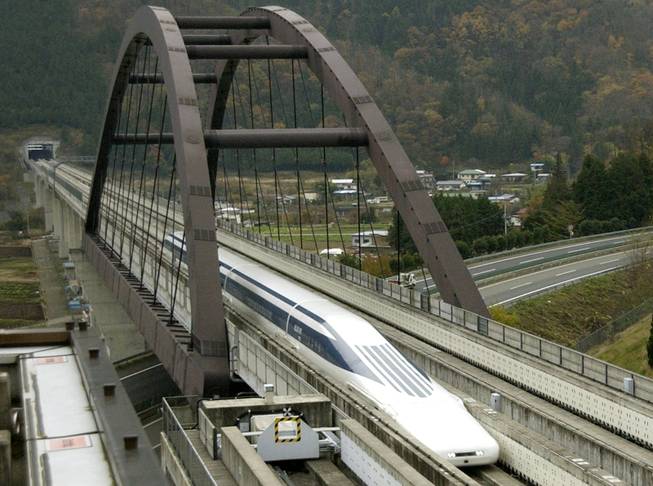
ASSOCIATED PRESS FILE
Plans for maglev train like the one being tested in Japan in 2003 to give travelers between Las Vegas and Southern California another alternative to Interstate 15 may get a boost from a the economic stimulus plan.
Monday, Dec. 22, 2008 | 2 a.m.
For over 20 years, boosters have dreamed of and lobbied for a train that could travel from Southern California to Las Vegas at 300 mph.
The proposed magnetic levitation train line linking Las Vegas and Anaheim, Calif. — attacked by critics as a multi-billion dollar pipe dream — has gained new life.
Near the bottom of a news release detailing Gov. Jim Gibbons’ meeting last month with President-elect Barack Obama was the announcement that Gibbons and California Gov. Arnold Schwarzenegger had agreed to move ahead with the high-speed train project.
“Arnold and I agreed to jointly work together on the project,” said Gibbons, who is planning to travel to Sacramento to talk with Schwarzenegger about it.
The train, Gibbons argues, should be a candidate for federal economic stimulus money.
The rail line, which would generally follow the route of Interstate 15 and cost between $12 billion and $13 billion, would create construction jobs on both sides of the state line and, once complete, speed the arrival of tourists to Las Vegas. (A trip between Las Vegas and Anaheim could take as little as 86 minutes.)
In June, Sen. Harry Reid, the Democratic majority leader, helped pass a bill that freed up $45 million for an environmental study of the route.
Obama and his advisers have been working with Congress on an economic stimulus package that would improve infrastructure and put people to work. The Washington Post on Friday put the size of the stimulus at $850 billion.
Yet to the critics, the bill is in danger of becoming one big pile of pork.
“We’re not exactly big fans of congressional earmarks, we’re also not a fan of just sending a big box of cash to states and cities for their own version of parochial pork barrel project,” said Steve Ellis, vice president of Taxpayers for Common Sense, a national nonpartisan budget watchdog group.
A push for the maglev project — a proposal which, he notes, “certainly has its detractors” — would add to the impression that special interests, states, cities and transportation advocates are behaving like greedy children with dreams of getting a pony for Christmas. (Las Vegas Mayor Oscar Goodman said last week that a new city hall, mob museum and performing arts center should be included in the stimulus package.)
But Ellis said any economic stimulus should yield an immediate benefit. The maglev project could take a decade or more to build. The federally required environmental impact study of the project would take from 18 months to two years.
“Something should get done,” Ellis said. “It should not be something that slowly bleeds, and the impact isn’t felt until after the recession is over.”
The Regional Transportation Commission of Southern Nevada will hold a news conference today with Reid to announce 60 projects that are “ready to go” within 180 days.
Jacob Snow, the RTC’s general manager, said these projects total about $1 billion, and include highway projects, interchanges, street paving and mass transit projects.
Snow wouldn’t comment specifically on the maglev project, but said: “We certainly think some sort of facility like maglev, a high-speed rail system between Southern California and Southern Nevada, is needed. No doubt about that.”
The first leg is planned for Las Vegas to Primm.
Reid spokesman Jon Summers said it’s too early to know what projects would be included in a federal economic stimulus bill. But a high-speed train between Las Vegas and Southern California “not only makes good economic sense for the state, it makes sense from an environmental and energy perspective as well,” he said.
Reid “supports any project that moves people quickly and safely between Nevada and California,” Summers said, citing frequent traffic jams on I-15.
Amtrak ended service between Las Vegas and Los Angeles in 1995.
Reid requested the Government Accountability Office prepare a feasibility study on a rail project between Las Vegas and Southern California, which Summers said should be out in the next three months.
The maglev, or magnetic-levitation, train would require a new set of “rails” — the train, suspended above the track by magnets, rides on a cushion of air. There are few commercial maglev trains operating worldwide, including in Japan and Shanghai, China.
A competing proposal for a faster train between Southern Nevada and Southern California would use conventional rails. That privately funded line would, however, run between Victorville, Calif., and Las Vegas.
Reid has criticized that project because he doesn’t think people will drive from Los Angeles to Victorville and then board a train to Las Vegas.
Bruce Aguilera, chairman of the Nevada-California Super Speed Train Commission, which oversees the maglev project, welcomed news of the governor’s support for the maglev project being included in an economic stimulus package.
Aguilera, who is also vice president and general counsel at MGM Mirage’s Bellagio, acknowledged that the maglev group has kept a low profile in recent years.
“We didn’t have things to say,” Aguilera said.
The project’s backers will break their silence next month, announcing how they plan to raise $11.25 million in matching funds needed to access the $45 million in federal funding.
With that money, Aguilera said, they plan to open an office in Las Vegas, start paying a staff member who has been working on a volunteer basis and re-launch their Web site.

Join the Discussion:
Check this out for a full explanation of our conversion to the LiveFyre commenting system and instructions on how to sign up for an account.
Full comments policy